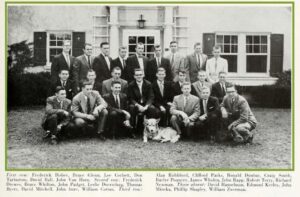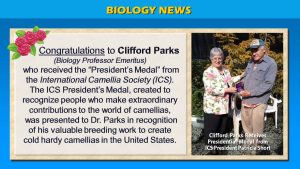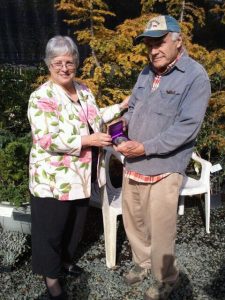(March 22, 1936 – July 18, 2020)1
The University of North Carolina at Chapel Hill Herbarium (NCU) has cataloged about 50 specimens collected by Clifford R. Parks. Without doubt more will be found as we continue to catalog our collections.
Clifford Robert Parks was born on 22 March 1936 to Clifford C. and Gladys Parks. While census and directories list Clifford, Sr.’s profession as mechanic and general contractor, the family referred to him as a carpenter. Gladys was a nurse in Elmira, Chemung County, New York.2,3,11 After graduating from Southside

High School in 1954, Parks earned a Bachelor of Science degree in 1958 from Cornell University and was a member of the Kappa Delta Rho fraternity.4,5
“During his senior year and immediately following graduation he studied artificial mutation induction at Cornell in the laboratory of Dr. A. M. Srb [Adrian Morris Srb, 1917-1977].”6
Parks earned his M.S. degree 1961 and his doctoral degree in 1963 in the Department of Genetics at North Carolina State College. The title of his Ph.D. dissertation was “Floral pigmentation studies in the genus Gossypium” and his thesis advisor was Dr. Stanley George Stephens. In addition to studying Gossypium at North Carolina State College, Parks collaborated with James Walker Hardin to describe Erythronium umbilicatum C. R. Parks & Hardin and Erythronium umbilicatum ssp. monostolum C. R. Parks & Hardin.6,7
In the spring of 1962 he took a leave from his graduate studies to work as a geneticist at the Los Angeles State & County Arboretum, and he returned to that position after earning his doctoral degree, and it was there that he started his research into the genus Camellia.1,6
While in Los Angeles he met his first spouse, Kai-Mei Chang (1937-2015), and together they had two sons, David and Robert.8,9
In addition to studying the genetics of Camellia, Cliff Parks also developed many Camellia cultivars. “Collected species of the genus Camellia, an illustrated outline” by Gao Jiyin, Clifford R. Parks, and Du Yuequiang describes 188 species of Camellia and “for each

species the botanical characteristics, distribution and horticultural merits are discussed in both English and Chinese. The species are grouped into sections which helps sort the many species into plants with similar characteristics. The distribution and elevation information helps one think about hardiness and adaptability to different climates. As the Chinese have grown some of these species there is useful information for the garden culture and breeding potential of many species. Of course the features of the plant are described quite completely down to the perules and chromosome number.”10
Parks joined the faculty of the Botany Department of the University of North Carolina at Chapel Hill in August, 1967. In addition to his teaching and research he served as the Director of the Coker Arboretum on campus (1983) and as Director of the Greenhouse (1984). He retired from the Biology faculty in June 2003.
In ca. 2015-2016 he married Gary Leung. Cliff Parks died on 18 July 2020, and is survived by his sons, David and Robert, and by his spouse, Gary.1

Graduate students at University of North Carolina at Chapel Hill advised by Cliff Parks:12
Pamela H. Griffith. M.A., 1972. Evolutionary relationships within the southeastern yellow-flowered species of Erythronium (Liliaceae).
Delbert E. Williams. M.A., 1974. A chemotaxonomic survey of four genomes of Gossypium.
Katsuhiko Kondo. Ph.D., 1975. Cytological studies in cultivated species of Camellia.
Wells, Elizabeth Fortson. Ph.D., 1977. A taxonomic study of the genus Heuchera in eastern North America. (also advised by Max H. Hommersand)
Marilou B. Curtis. M.S., 1978. Study of variation of Betula lenta.
Karen McAlpin McDougal. M.S., 1979. An analysis of variation in leaf flavonoids of Quercus rubra L., over an altitudinal gradient.
Susan K. Gerbeth. M.S., 1980. The major flavonoids of Betula lenta.
Jonathan Fox Wendel. M.S., 1980. Genetic control of isozyme variation in Camellia japonica L. (Theaceae).
Kathryn P. Seaton. M.S., 1981. A natural heritage study of Larkspur Ridge Natural Area, Halifax County, North Carolina.
Jeri Welsh Higginbotham. M.S., 1982. Pollen grain diameters of the Southern Appalachian birches.
Jonathan Fox Wendel. Ph.D., 1983. Electrophoretic analysis of genetic variation in wild and cultivated Camellia japonica L.
Karen McAlpin McDougal. Ph.D., 1984. Patterns of variation in the foliar flavonoids of red oak, Quercus rubra L., and their relationships to migration and evolution of the species.
Karl Arthur Suiter. M.A., 1984. Genetics of alloenzyme variation in Gossypium arboreum L. and Gossypium herbaceum L. (Malvaceae).
Allen R. Howard, III. M.S., 1986. Genetic control of phosphoglucose isomerase and triosephosphate isomerase in Acer rubrum L.
Jeri Welsh Higginbotham. Ph.D., 1987. Morphological and isoenzymic variation in southern Appalachian Betula alleghaniensis Britt. and B. lenta L.
Gloria May Caddell. Ph.D., 1989. Pollination, mating system and distribution of genetic variation within populations of Camellia japonica L. (Theaceae).
Margaret Tevis Hoey. Ph.D., 1990. Patterns of genetic divergence within the vicariad genus Liquidambar L. (Hamamelidaceae).
Yongan Wang. M.S., 1991. Manual of trees and shrubs distributed in warm temperate zones of China.
Bradford E. Saxe. M.S., 1992. Ribosomal DNA and plant phylogenetics–Its sequence divergence in Platanus.
Mitchell Martin Sewell. Ph.D, 1992. Mating system and molecular variation in Liriodendron tulipifera L. (Magnoliaceae).
Qiu, Yin-Long. Ph.D., 1993. Molecular divergence between Asian and North American species of Magnolia sect. Rytidospermum (Magnoliaceae)
Charles M. Stuart. M.S., 1993. A preliminary analysis of internal transcribed sequence of ribosomal DNA from three Camellia and one Gordonia species. (also advised by Mark W. Chase)
Warren D. Hauk. Ph.D., 1996. Phylogenetics of Ophioglossaceae : the evolutionary consequences of morphological reduction. (also advised by Mark W. Chase)
Linda M. Prince. Ph.D., 1998. Systematics of the Theoideae (Theaceae) and the resolution of morphological, anatomical, and molecular data.
Alice Margaret Stanford. Ph.D. 1998. The biogeography and phylogeny of Castanea, Fagus, and Juglans based on matK and its sequence data.
Barbara H. Thakor. Ph.D., 1998. Phylogenetic relationships among the species of the genus Camellia (Theaceae).
Norihiro Yoshikawa. Ph.D. 1999. Morphology and molecular analysis of Camellia japonica L. and closely related taxa from eastern China.
Kenneth John Wurdack. Ph.D., 2002. The molecular systematics and evolution of Euphorbiaceae sensu lato.
Fatih Coskun. Ph.D., 2003. The phylogeny and biogeography of Osmanthus, Cercis, and Tilia based on its nuclear ribosomal, NDHF and TRNL-F Chloroplast DNA sequence data.

PUBLICATIONS: (incomplete)
Parks, Clifford R., Jonathan F. Wendel, Mitchell M. Sewell and Yin-Long Qiu. 1994. The Significance of Allozyme Variation and Introgression in the Liriodendron tulipifera Complex (Magnoliaceae). American Journal of Botany 81(7): 878-889.
https://doi-org.libproxy.lib.unc.edu/10.2307/2445769
Hoey, Margaret T. and Clifford R. Parks. 1994. Genetic Divergence in Liquidambar styraciflua, L. formosana, and L. acalycina (Hamamelidaceae). Systematic Botany 19 (2): 308-316. https://doi-org.libproxy.lib.unc.edu/10.2307/2419604
Wendel, Jonathan F. and Clifford R. Parks. 1985. Genetic Diversity and Population Structure in Camellia japonica L. (Theaceae). American Journal of Botany 72 (1): 52-65.
https://doi-org.libproxy.lib.unc.edu/10.2307/2443568
SOURCES:
1. “Clifford Robert Parks” Obituary. News & Observer 29 July 2020. Raleigh, North Carolina.
2. Year: 1940; Census Place: Elmira, Chemung, New York; Roll: m-t0627-02514; Page: 11A; Enumeration District: 8-53. Ancestry.com. 1940 United States Federal Census [database on-line]. Provo, UT, USA: Ancestry.com Operations, Inc., 2012. Original data: United States of America, Bureau of the Census. Sixteenth Census of the United States, 1940. Washington, D.C.: National Archives and Records Administration, 1940. T627, 4,643 rolls.
3. Manning’s Elmira Directory, 1956. (page 518). Ancestry.com. U.S., City Directories, 1822-1995 [database on-line]. Provo, UT, USA: Ancestry.com Operations, Inc., 2011.
4. “Kappa Delta Rho”. 1957. Cornellian Yearbook, 1957, page 179. Cornell University. Ithaca, New York. Ancestry.com. U.S., School Yearbooks, 1900-1999 [database on-line]. Lehi, UT, USA: Ancestry.com Operations, Inc., 2010.
5. Southside HS yearbook [incomplete citation]
6. Parks, Clifford Robert. 1963. Flora pigmentation studies in the genus Gossypium. Ph.D. thesis, Department of Genetics, North Carolina State College, Raleigh, North Carolina.
7. Parks, Clifford R. and James W. Hardin. 1963. Yellow Erythroniums of the Eastern United States. Brittonia 15(3): 252–259.
8. Publication Date: 21/ May/ 1964; Publication Place: Monrovia, California, USA; URL: https://www.newspapers.com/image/606154048/?article=41c34f0d-53e9-433a-a53c-2eceda363e25/4f61241f-d62c-43a5-b1ea-3e18d24fd8a3&focus=0.27969596,0.84042877,0.5112509,0.96954286&xid=3398. Ancestry.com. U.S., Newspapers.com Marriage Index, 1800s-1999 [database on-line]. Lehi, UT, USA: Ancestry.com Operations Inc, 2020.
9. Obituary of Kai Mei Parks, 2015. https://walkersfuneralservice.com/tribute/details/1039/Kai-Parks/obituary.html accessed 18 January 2021.
10. https://camforest.com/products/b-collected accessed on 18 January 2021.
11. Personal communication, Burk to McCormick, email of 1 Jan 2024. “I interviewed Cliff in 2007 and 2008 and recorded my notes. Cliff stated that his father was a carpenter and his mother a nurse. David Parks recently confirmed this. In various conversations with Cliff, he also noted his father was a carpenter.”
12. List of Parks’ advisees provided by Bill Burk, Librarian, John N. Couch Biology Library, University of North Carolina at Chapel Hill.
